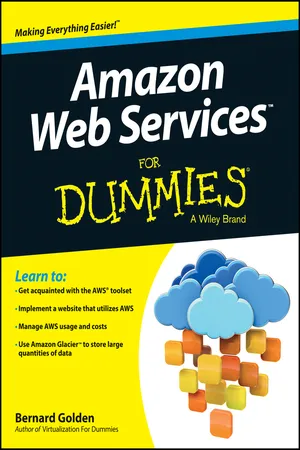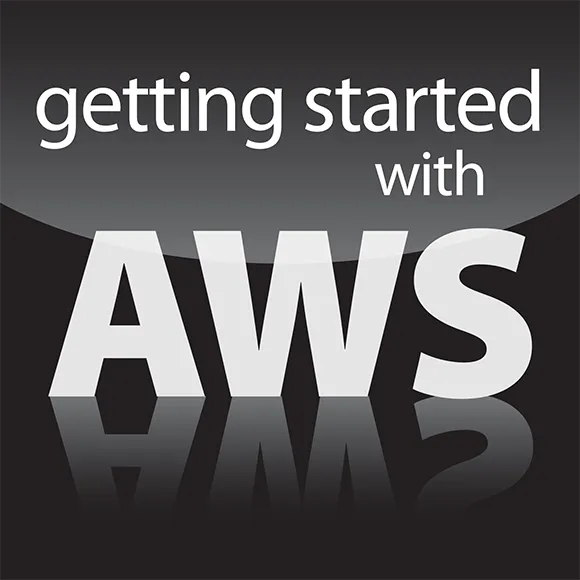
- English
- ePUB (mobile friendly)
- Available on iOS & Android
eBook - ePub
Amazon Web Services For Dummies
About this book
Create dynamic cloud-based websites with Amazon Web Services and this friendly guide!
As the largest cloud computing platform in the world, Amazon Web Services (AWS) provides one of the most popular web services options available. This easy-to-understand guide is the perfect introduction to the Amazon Web Services platform and all it can do for you. You'll learn about the Amazon Web Services tool set; how different web services (including S3, Amazon EC2, and Amazon Flexible Payments) and Glacier work; and how you can implement AWS in your organization.
- Explains how to use Amazon Web Services to store objects, take payments, manage large quantities of data, send e-mails, deploy push notifications, and more from your website
- Details how AWS can reduce costs, improve efficiency, increase productivity, and cut down on expensive hardware investments - and administrative headaches - in your organization
- Includes practical examples and helpful step-by-step lists to help you experiment with different AWS features and create a robust website that meets your needs
Amazon Web Services For Dummies is exactly what you need to get your head in the cloud with Amazon Web Services!
Frequently asked questions
Yes, you can cancel anytime from the Subscription tab in your account settings on the Perlego website. Your subscription will stay active until the end of your current billing period. Learn how to cancel your subscription.
At the moment all of our mobile-responsive ePub books are available to download via the app. Most of our PDFs are also available to download and we're working on making the final remaining ones downloadable now. Learn more here.
Perlego offers two plans: Essential and Complete
- Essential is ideal for learners and professionals who enjoy exploring a wide range of subjects. Access the Essential Library with 800,000+ trusted titles and best-sellers across business, personal growth, and the humanities. Includes unlimited reading time and Standard Read Aloud voice.
- Complete: Perfect for advanced learners and researchers needing full, unrestricted access. Unlock 1.4M+ books across hundreds of subjects, including academic and specialized titles. The Complete Plan also includes advanced features like Premium Read Aloud and Research Assistant.
We are an online textbook subscription service, where you can get access to an entire online library for less than the price of a single book per month. With over 1 million books across 1000+ topics, we’ve got you covered! Learn more here.
Look out for the read-aloud symbol on your next book to see if you can listen to it. The read-aloud tool reads text aloud for you, highlighting the text as it is being read. You can pause it, speed it up and slow it down. Learn more here.
Yes! You can use the Perlego app on both iOS or Android devices to read anytime, anywhere — even offline. Perfect for commutes or when you’re on the go.
Please note we cannot support devices running on iOS 13 and Android 7 or earlier. Learn more about using the app.
Please note we cannot support devices running on iOS 13 and Android 7 or earlier. Learn more about using the app.
Yes, you can access Amazon Web Services For Dummies by Bernard Golden in PDF and/or ePUB format, as well as other popular books in Computer Science & Entreprise Applications. We have over one million books available in our catalogue for you to explore.
Information
Part I
Getting Started with AWS


www.dummies.com for great Dummies content online.In this part . . .
- See how Amazon designed Amazon Web Services from the beginning to be extremely scalable, modular in design, and highly robust.
- Find out how AWS reflects Amazon’s unique approach to operating its business.
- Get an introduction to AWS, its business and technology underpinnings, and even get a small taste of hands-on use.
- Visit
www.dummies.comfor great Dummies content online.
Chapter 1
Amazon Web Services Philosophy and Design
In This Chapter
- Figuring out the cloud
- Watching Amazon grow from retailer to the world’s first cloud provider
- Understanding the foundation of Amazon Web Services
- Introducing the Amazon Web Services ecosystem
- Seeing how the network effect helps you
- Comparing Amazon Web Services to other cloud computing providers
You may be forgiven if you’re puzzled about how Amazon, which started out as an online bookstore, has become the leading cloud computing provider. This chapter solves that mystery by discussing the circumstances that led Amazon into the cloud computing services arena and why Amazon Web Services, far from being an oddly different offering from a retailer, is a logical outgrowth of Amazon’s business.
This chapter also compares Amazon’s cloud offering to other competitors in the market and explains how its approach differs. As part of this comparison, I present some statistics on the size and growth of Amazon’s offering, while describing why it’s difficult to get a handle on its exact size.
The chapter concludes with a brief discussion about the Amazon Web Services ecosystem and why it is far richer than what Amazon itself provides — and why it offers more value for users of Amazon’s cloud service.
But before I reveal all the answers to the Amazon mystery, I answer an even more fundamental question: What is all this cloud computing stuff, anyway?
Cloud Computing Defined
I believe that skill is built on a foundation of knowledge. Anyone who wants to work with Amazon Web Services (AWS, from now on) should have a firm understanding of cloud computing — what it is and what it provides.
IaaS, Paas, SaaS
As a general overview, cloud computing refers to the delivery of computing services from a remote location over a network. The National Institute of Standards and Technology (NIST), a U.S. government agency, has a definition of cloud computing that is generally considered the gold standard. Rather than trying to create my own definition, I always defer to NIST’s definition. The following information is drawn directly from it.
Cloud computing is a model for enabling ubiquitous, convenient, on-demand network access to a shared pool of configurable computing resources (e.g., networks, servers, storage, applications, and services) that can be rapidly provisioned and released with minimal management effort or service provider interaction.
This cloud model is composed of five essential characteristics:
- On-demand self-service: A consumer can unilaterally provision computing capabilities, such as server time and network storage, automatically as needed without requiring human interaction with each service provider.
- Broad network access: Capabilities are available over the network and accessed via standard mechanisms that promote use by heterogeneous thin or thick client platforms (such as mobile phones, tablets, laptops, and workstations).
- Resource pooling: The provider’s computing resources are pooled to serve multiple consumers using a multi-tenant model, with different physical and virtual resources dynamically assigned and reassigned according to consumer demand. There’s a sense of so-called location independence, in that the customer generally has no control or knowledge over the exact location of the provided resources but may be able to specify location at a higher level of abstraction (by country, state, or data center, for example). Examples of resources are storage, processing, memory, and network bandwidth.
- Rapid elasticity: Capabilities can be elastically provisioned and released, in some cases automatically, to scale rapidly outward and inward commensurate with demand. To the consumer, the capabilities available for provisioning often appear to be unlimited and can be appropriated in any quantity at any time.
- Measured service: Cloud systems automatically control and optimize resource use by leveraging a metering capability at a level of abstraction that’s appropriate to the type of service (storage, processing, bandwidth, or active user accounts, for example). Resource usage can be monitored, controlled, and reported, providing transparency for both the provider and consumer of the utilized service.
Cloud computing is commonly characterized as providing three types of functionality, referred to IaaS, PaaS, and SaaS, where aaS is shorthand for “as a service” and service implies that the functionality isn’t local to the user but rather originates elsewhere (a location in a remote location accessed via a network). The letters I, P, and S in the acronyms refer to different types of functionality, as the following list makes clear:
- Infrastructure as a Service (Iaas): Offers users the basic building blocks of computing: processing, network connectivity, and storage. (Of course, you also need other capabilities in order to fully support IaaS functionality — such as user accounts, usage tracking, and security.) You would use an IaaS cloud provider if you want to build an application from scratch and need access to fairly low-level functionality within the operating system.
- Platform as a Service (PaaS): Instead of offering low-level functions within the operating system, offers higher-level programming frameworks that a developer interacts with to obtain computing services. For example, rather than open a file and write a collection of bits to it, in a PaaS environment the developer simply calls a function and then provides the function with the collection of bits. The PaaS framework then handles the grunt work, such as opening a file, writing the bits to it, and ensuring that the bits have been successfully received by the file system. The PaaS framework provider takes care of backing up the data and managing t...
Table of contents
- Cover
- Title Page
- Copyright
- Table of Contents
- Introduction
- Part I: Getting Started with AWS
- Part II: Diving into AWS Offerings
- Part III: Using AWS
- Part IV: The Part of Tens
- About the Author
- Cheat Sheet
- Connect with Dummies
- End User License Agreement